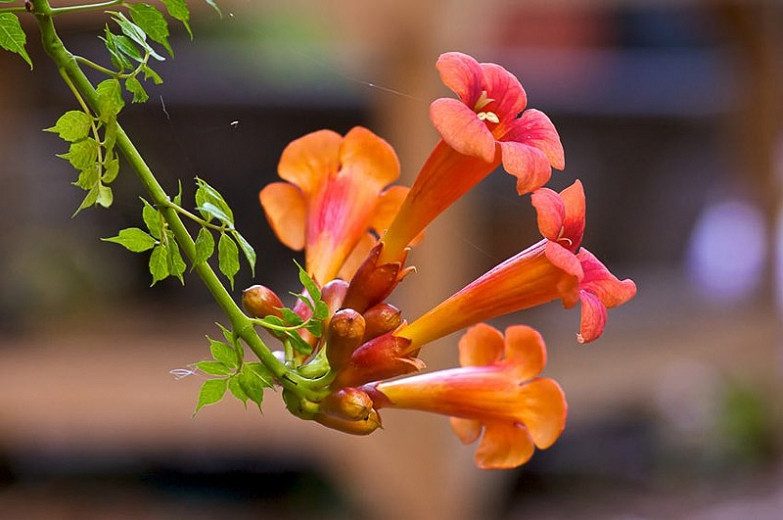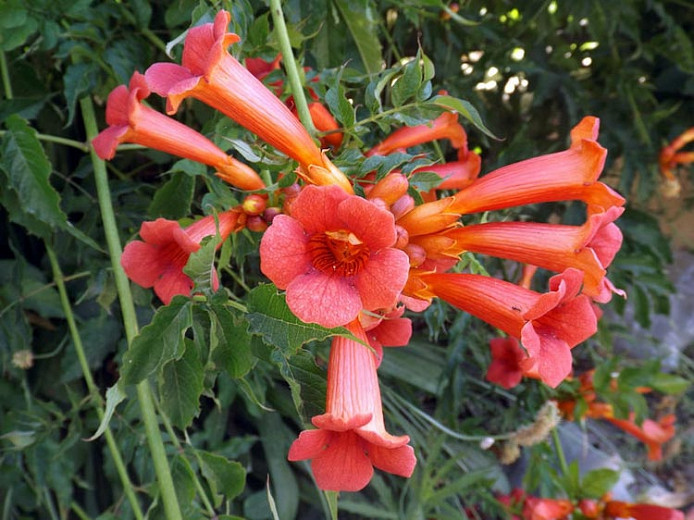Campsis radicans (Trumpet Vine)
A vigorous North American native, Campsis radicans (Trumpet Vine) is a self-clinging woody climber with particularly showy trumpet-shaped flowers, 3 in. long (8 cm) in bright shades of orange or red. Appearing throughout the summer, these magnificent tubular flowers are borne in clusters at the ends of the branches and provide a long-lasting and spectacular floral display. Hummingbirds love them and never fail visiting them. The blooms are followed by attractive bean-like seedpods. The foliage of pinnate, shiny, dark green leaves above and glabrous dull green below, is deciduous.
Climbing or scrambling over everything in its path by aerial rootlets, which can damage wood, stone, and brick (like English Ivy), Campsis radicans is however useful for erosion control. Often cultivated for its attractive, glowing flowers, this vine is widely grown in Mediterranean gardens. Make sure you keep it under tight control as it has an aggressive colonizing tendency.
- Blooming from early to late summer, this extremely floriferous Trumpet Vine is heat, cold and drought tolerant.
- Thrives in lean to average, moist, well-drained soils, in full sun or part shade. Tolerates however a wide variety of soils, including dry soils. Best flower production is obtained in full sun.
- Hardy and easy to grow, this Trumpet Vine is incredibly free-flowering and can quickly grow up to 20-40 ft. long (6-12 m). It suckers profusely from underground runners and freely self-seeds, often forming dense colonies in the wild.
- No serious insect or disease problems.
- Excellent choice for trellises, walls, fences or arbors.
- This vine blooms on new growth and should be pruned in late winter or early spring. Cut back branches to within three to four buds. This will encourage a more compact growth and promote the formation of flower buds in the shortened shoots. Overcrowded, diseased or damaged shoots can be removed at the same time.
- Native from eastern North America from Indiana, Ohio and New Jersey down to Florida and eastern Texas and north to South Dakota.
Requirements
| Hardiness | 5 – 9 |
|---|---|
| Heat Zones | 3 – 9 |
| Climate Zones | 1, 1A, 1B, 2, 2A, 2B, 3, 3A, 3B, 4, 5, 6, 7, 8, 9, 10, 11, 12, 13, 14, 15, 16, 17, 18, 19, 20, 21 |
| Plant Type | Climbers |
| Plant Family | Campsis – Trumpet Vines |
| Exposure | Full Sun, Partial Sun |
| Season of Interest | Summer (Early,Mid,Late) |
| Height | 20' – 40' (6m – 12m) |
| Spread | 5' – 10' (150cm – 3m) |
| Water Needs | Low, Average |
| Maintenance | High |
| Soil Type | Chalk, Clay, Loam, Sand |
| Soil pH | Acid, Alkaline, Neutral |
| Soil Drainage | Moist but Well-Drained, Well-Drained |
| Characteristics | Showy |
| Native Plants | United States, Midwest, Illinois, Indiana, Iowa, Kansas, Michigan, Missouri, Nebraska, North Dakota, Ohio, South Dakota, Wisconsin, Northeast, Connecticut, Delaware, Massachusetts, Maryland, New Hampshire, New Jersey, New York, Pennsylvania, Rhode Island, Rocky Mountains, Colorado, Utah, Southeast, Alabama, Arkansas, Florida, Georgia, Kentucky, Louisiana, Mississippi, North Carolina, South Carolina, Tennessee, Virginia, West Virginia, Southwest, Oklahoma, Texas |
| Tolerance | Clay Soil, Deer, Drought, Dry Soil |
| Attracts | Hummingbirds |
| Garden Uses | Arbors, Pergolas, Trellises, Wall-Side Borders, Walls and Fences |
| Garden Styles | Informal and Cottage, Mediterranean Garden |




